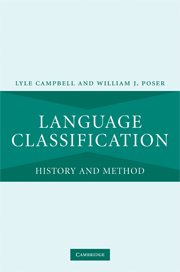Book contents
- Frontmatter
- Contents
- List of figures, tables, and charts
- Acknowledgments
- Preface
- 1 Introduction: how are languages shown to be related to one another?
- 2 The beginning of comparative linguistics
- 3 “Asiatic Jones, Oriental Jones”: Sir William Jones’ role in the raise of comparative linguistics
- 4 Consolidation of comparative linguistics
- 5 How some languages were shown to belong to Indo-European
- 6 Comparative linguistics of other language families and regions
- 7 How to show languages are related: the methods
- 8 The philosophical–psychological– typological–evolutionary approach to language relationships
- 9 Assessment of proposed distant genetic relationships
- 10 Beyond the comparative method?
- 11 Why and how do languages diversify and spread?
- 12 What can we learn about the earliest human language by comparing languages known today?
- 13 Conclusions: anticipating the future
- Appendix: Hypothesized distant genetic relationships
- References
- Index
11 - Why and how do languages diversify and spread?
Published online by Cambridge University Press: 22 September 2009
- Frontmatter
- Contents
- List of figures, tables, and charts
- Acknowledgments
- Preface
- 1 Introduction: how are languages shown to be related to one another?
- 2 The beginning of comparative linguistics
- 3 “Asiatic Jones, Oriental Jones”: Sir William Jones’ role in the raise of comparative linguistics
- 4 Consolidation of comparative linguistics
- 5 How some languages were shown to belong to Indo-European
- 6 Comparative linguistics of other language families and regions
- 7 How to show languages are related: the methods
- 8 The philosophical–psychological– typological–evolutionary approach to language relationships
- 9 Assessment of proposed distant genetic relationships
- 10 Beyond the comparative method?
- 11 Why and how do languages diversify and spread?
- 12 What can we learn about the earliest human language by comparing languages known today?
- 13 Conclusions: anticipating the future
- Appendix: Hypothesized distant genetic relationships
- References
- Index
Summary
Australian aborigines … say that there was an old woman named Wururi, who went out at night and used to quench the fires with a great stick. When this old woman died the people tore her corpse to pieces. The Southern tribes coming up first ate her flesh, and immediately gained a very clear language. The Eastern and the Northern tribes, who came later, spoke less intelligible dialects.
(Farrar 1873:106)Introduction
What drives linguistic diversification? Why do languages split up and become families of related languages? What accounts for languages spreading to new territory? Because answers to how and why languages diversify into families of related languages are closely connected with issues of genetic affinity and linguistic classification, in this chapter we survey some of the main approaches which propose answers to these questions. We identify misleading claims and attempt to offer directions towards more adequate answers.
As mentioned in Chapter 1, throughout history there have been numerous theories about what causes languages to diversify, accounts involving, for example, migration, war and conquest, trade, geographical isolation, cessation of communication, social and economic organization (e.g. mounted warriors with expansionist proclivities, militaristic patriarchy), linguistically marked group identity entailing rights to resources, technological advantage (in, for example, food production, herding, navigation, metallurgy, military organization), even divine vengeance for the Tower of Babel caper.
Information
- Type
- Chapter
- Information
- Language ClassificationHistory and Method, pp. 330 - 363Publisher: Cambridge University PressPrint publication year: 2008
